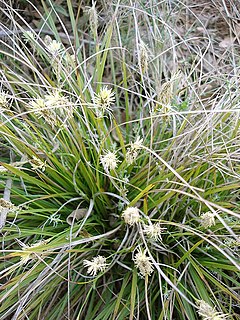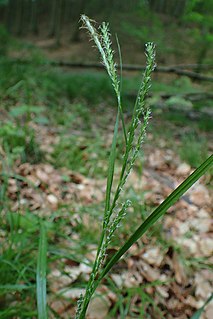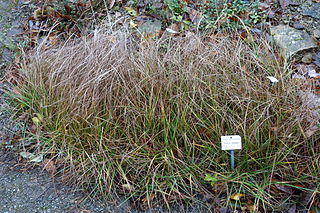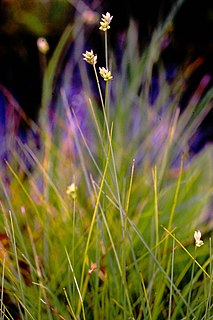
The Cyperaceae are a family of graminoid (grass-like), monocotyledonous flowering plants known as sedges. The family is large, with some 5,500 known species described in about 90 genera, the largest being the "true sedges" genus Carex with over 2,000 species.

Nyctanthes arbor-tristis, also known as the Night-flowering jasmine or Parijat , is a species of Nyctanthes native to South Asia and Southeast Asia.

Ornamental grasses are grasses grown as ornamental plants. Ornamental grasses are popular in many colder hardiness zones for their resilience to cold temperatures and aesthetic value throughout fall and winter seasons.

Carex is a vast genus of more than 2,000 species of grass-like plants in the family Cyperaceae, commonly known as sedges. Other members of the family Cyperaceae are also called sedges, however those of genus Carex may be called true sedges, and it is the most species-rich genus in the family. The study of Carex is known as caricology.
Flora of Azerbaijan or Vegetation of Azerbaijan refers to the plants, trees, flowers which can be found in Azerbaijan.

In the Appalachian Mountains of the eastern United States, balds are mountain summits or crests covered primarily by thick vegetation of native grasses or shrubs occurring in areas where heavy forest growth would be expected.

Carex lasiocarpa is a broadly distributed species of wetland sedge sometimes known as woollyfruit sedge or slender sedge. It is considered a species of Least Concern by the IUCN Red List due to its extensive range with many stable populations.

Carex nigra is a perennial species of plants in the family Cyperaceae native to wetlands of Europe, western Asia, northwestern Africa, and eastern North America. Common names include common sedge, black sedge or smooth black sedge. The eastern limit of its range reaches central Siberia, Turkey and probably the Caucasus.

Carex festucacea, or fescue sedge, is a species of sedge that lives in eastern North America. It has been described as "a soft, gray green, wisp, to 2', with narrow leaves and somewhat taller stems, topped by an interrupted spike, with lower spikelets, shaped a bit like an overflowing ice cream cone. The spike axis is often arched at the summit, but the alternating spikelets around the axis create a zig zag appearance. The seed sacs have a humped shoulder."

Denticucullus pygmina, the small wainscot, is a moth of the family Noctuidae. It is found in most of Europe, ranging from northern Spain, through Portugal as far north as Finland. In the east it is found across the Palearctic to the Russian Far East and western Siberia. It is also found in North Africa, Turkey, the Caucasus region and northern Iran.
Carex merritt-fernaldii, or Fernald's sedge, is a species of sedge from northeastern North America. It was first described by Kenneth Mackenzie in 1923. It is named after botanist Merritt Fernald.

Carex divulsa, the grey sedge, is a species of flowering plant in the genus Carex, native to Macaronesia, Europe, northwest Africa, the Caucasus region, and the Middle East as far east as Turkmenistan. It has been introduced to northeast Argentina, the District of Columbia and Pennsylvania in the United States, Ontario in Canada, the North Island of New Zealand, and Tasmania and Victoria in Australia. It is the namesake of the Carex divulsa aggregate.

Carex supina, called the weak arctic sedge, is a species of flowering plant in the genus Carex, native to Alaska, western and central Canada, Minnesota, Greenland, central and eastern Europe, the Caucasus region, Central Asia, Siberia, the Himalaya, the Amur region, Manchuria, and Korea. It is often found in association with Festuca altaica and Poa glauca.

Carex strigosa, the thin-spiked wood sedge, is a species of flowering plant in the genus Carex, native to Europe and the Caucasus region. Its diploid chromosome number is 2n=66.

Carex buekii, the banat sedge, is a species of flowering plant in the genus Carex, native to central, southeastern and eastern Europe, the Caucasus region, Anatolia, and the northern Levant. It forms large stands in the floodplains of central European rivers.

Carex brevicollis is a species of sedge, found in Spain, France, Slovakia, Hungary, Romania, Bulgaria, Ukraine, the former Yugoslavia, Anatolia, the north Caucasus, and the Transcaucasus. It prefers to grow in calcareous mountain grasslands.

Carex liparocarpos is a species of sedge, native to southern Europe, and the Atlas and Caucasus regions. It is typically found growing in sandy steppes, dunes, riverine gravel deposits, and scree.

Carex tenuiflora, the sparse-flowered sedge, is a species of flowering plant in the family Cyperaceae. It is native to the Subarctic and Hemiboreal Northern Hemisphere; Alaska, Canada, the northern US, Scandinavia, the Baltic States, all of Russia, the north Caucasus, Siberia, the Russian Far East, Mongolia, northern China, Korea, and Japan. It is most often found in peatlands, preferring a pH of 6.

Carex elongata, the elongated sedge, is a species of flowering plant in the family Cyperaceae, native to Europe, the Caucasus, western Siberia, Kazakhstan, and the Altai. It occurs in boggy woodland and wet meadows, where it forms dense tussocks up to about 1 m tall.

Carex michelii is a species of sedge, native to central, southern and eastern Europe, Turkey, the Caucasus, and Iran. It is typically found in semi‑arid grasslands.


















